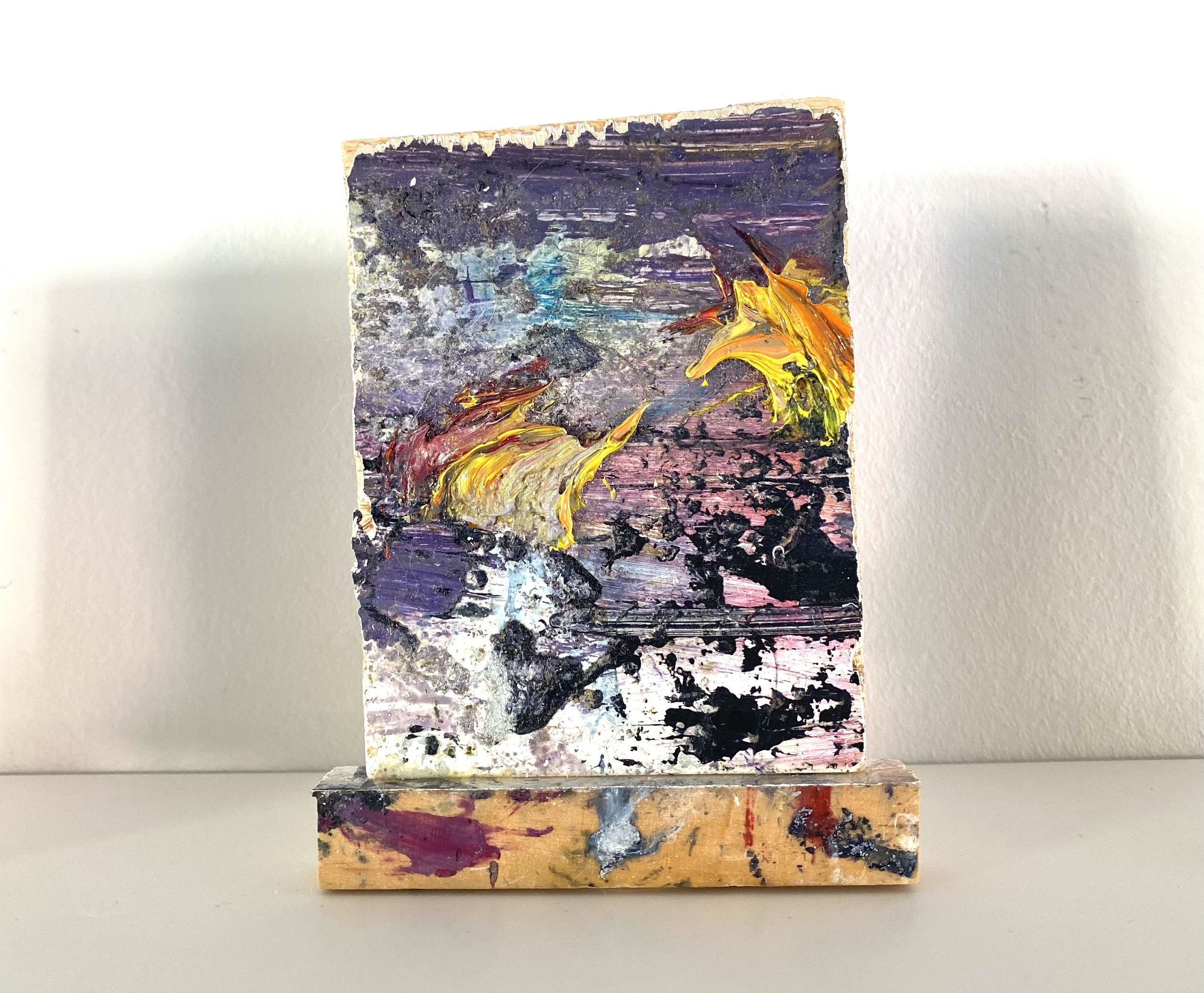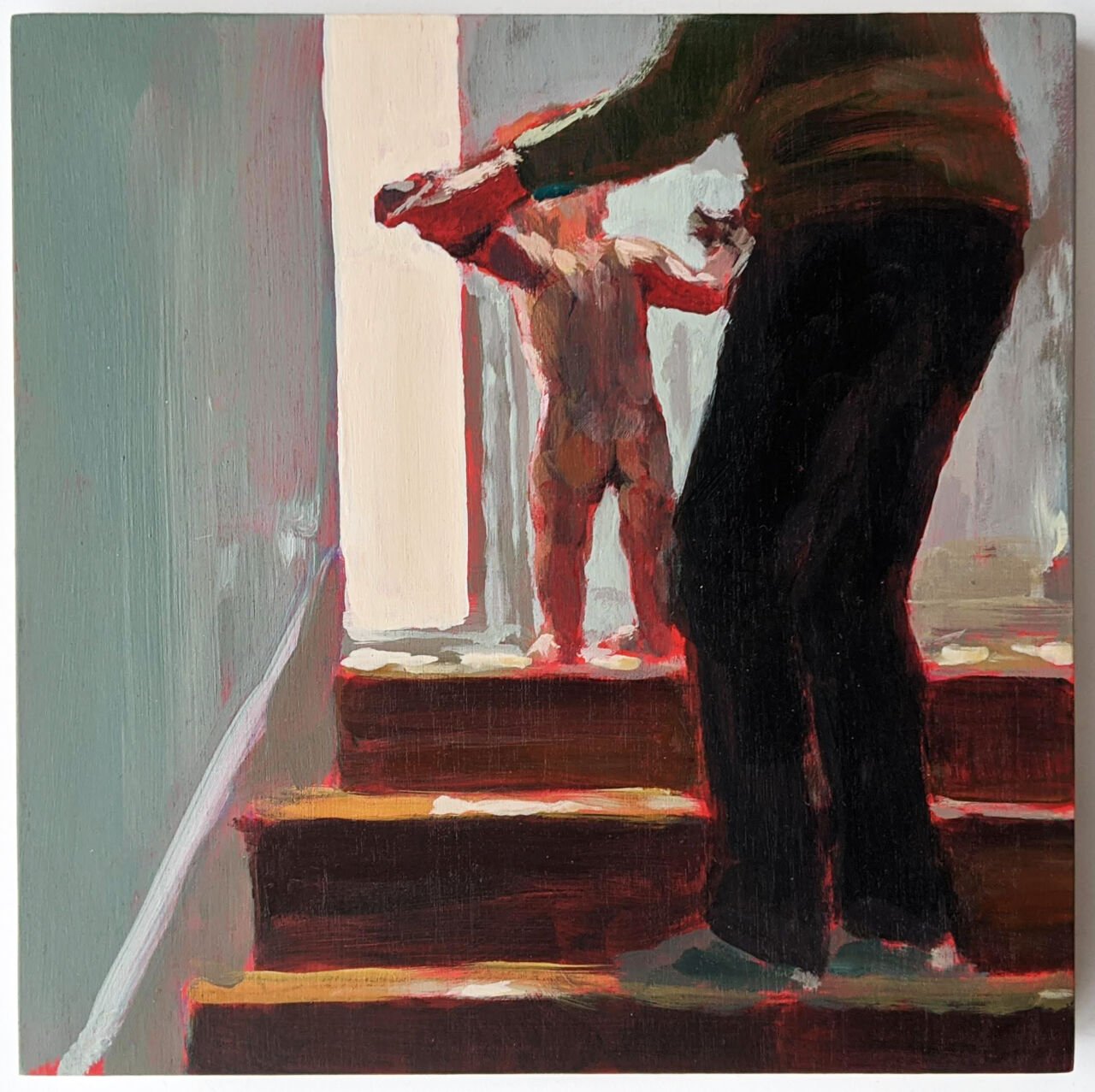Anna Shukeylo on Barbara Laube: For Love of Painting and Rebirth
Barbara Laube, Installation at Gold Scopophilia Gallery
Barbara Laube’s recent gem-like body of work, Morning Has Broken, at Gold Scopophilia Gallery, includes the artist’s most radiant and most unusual works to date. The gold-kissed paintings incorporate remnants of her older pieces, from as far back as the 80s. The tiny but mighty works pack a powerful punch, but have a candy-like appeal. The shimmering echoes of gold leaf catch the eye from across the room, drawing one in to reveal complex brushwork.
Barbara Laube, Morning Has Broken, 2022, Oil and linen on panel. 5 x 4 inches
The most tempting are the pieces that resemble artisanal decorated chocolates. These gold-leafed miniatures, each barely two inches across, are especially playful when displayed in a cluster. The delicious little works play off of each other, as in Morning HasBroken, where the rhythm of the arrangement evokes a symphony of relationships. Some, such as Saucers of Milk, are almost literally the color of a dessert. A rich raspberry and cream sorbet-colored brushstroke envelops the two-inch surface, recalling a personal, domestic moment.
Barbara Laube, Saucers of Milk, 2021, Oil and gold leaf on canvas. 2 x 1.75 inches
Within the same series, pieces that are more sculptural drum up a different tune, equally upbeat but with more pronounced rhythm. Each stands as a monument to a memory. The action-filled brushstrokes have been frozen in time. The titles offer clues. “Dorothy’s Dress” refers to the artist’s mother’s dress. “Sunrise” is a recollection from a personal trip, its action-filled brushstrokes freezing time. The irregularly shaped assembled panels are like trills within a symphony of curated works. Their unusual assemblage comes together as if the artist is making sense of a fragmented mental space. Their rough edges are not hidden. The raw evidence of their construction is visible in profile and on the surface.
Barbara Laube, Blowing Up the House, 2021, Oil on linen and panel. 6.5 x 5 inches
Some of the works are compiled in a “trinity” formation such as in Blowing Up the House, which hints at Laube’s love of gold-adorned religious triptychs of the Middle Ages. The allusion to 15th century masterpieces is an ongoing motif in Laube’s work, who frequents those corners of the Metropolitan Museum. In this case, she seems to point towards the miniature gold-leafed manuscripts: relics of a personal nature. Her particular hybrid, however, mixes in Ab-Ex influences. Her marks are fast and disconnected. Raw linen peaks through on the surface in works such as Morning Has Broken. Both the medieval and the modern references aid her in creating spiritual odes to psychological resolution: small moments of Zen-like tranquility.
Barbara Laube, Abadiania2, 2021, Oil and linen on panel. 5 x 3 inches
Laube also includes painted sculptural pieces such Abediania 2 which stands five inches tall with all its might. Each of its brushstrokes might have been done with a brush much larger than the piece itself.Laube’s older, much larger work is darker, weighted with the use of gold, copper and silver leaf which serve to examine heavier existential dilemmas as in her When Air Becomes Breath series from 2018. They reflect on heavier themes such as the nature of existence and religion. The pieces in Morning Has Broken, in comparison, are the crème de la crème, the sweetest notes of the older paintings. Having been physically cut out from older works, they are literally the dessert of the whole meal, satisfying and delicious confections of light, color and texture. These tiny pieces can easily hold a wall on their own.
Barbara Laube, Installation at Gold Scopophilia Gallery
Laube’s current pieces elicit lightness and positivity. There is hope and resolution within them. There is an acceptance that this is what they are, no more nor less, and this is exactly how they should be. Small but mighty in presence, they don’t pretend to be anything they are not. Size speaks volumes here, as there is no room for complication or uncertainty. The works have more color than the artist has ever used before. As one walks through the exhibition, flashes of beet pink, pastel violet, and phthalo blue, gesturally intertwining on miniature surfaces, shimmer with pure pleasure and delight.
Anna Shukeylo, Repose8, 2021, Acrylic on panel, 8 x 8 inches
Anna Shukeylo is a Russian born artist, curator, educator, and writer. Her current autobiographical series explores the beauty and complexity of parenthood.







